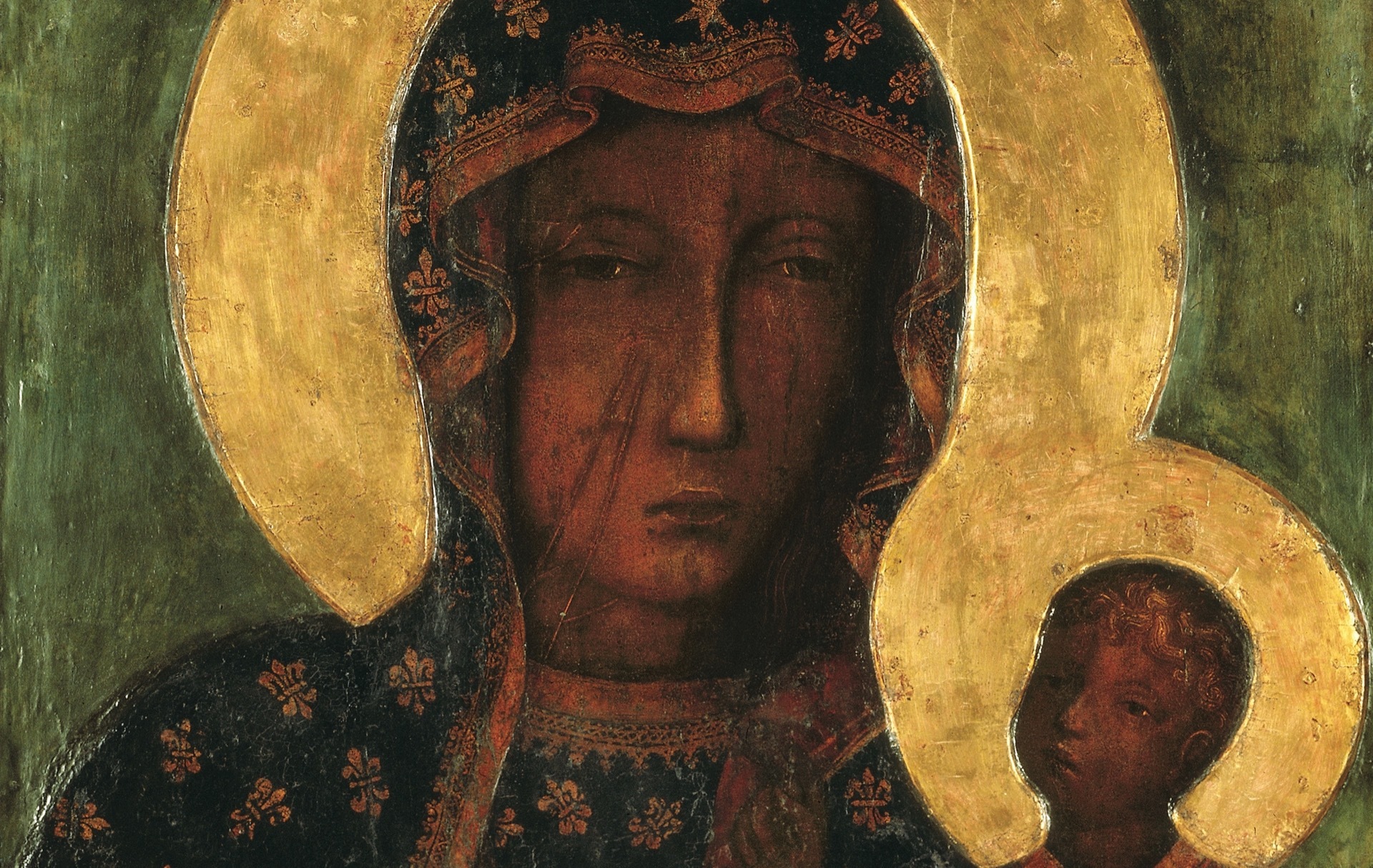This is translated from Polish that appeared on jasnagora.com under Source materials and scientific studies and titled ‘Skarby Jasnej Góry – Ozdobiona liliami…‘ written by O. Jan Stanislaw Rudzinski OSPPE.
We consider the symbolism of the decoration: the star and the lilies adorning Our Lady’s garments from the Jasna Gora image. We present the symbolism of the lily motif on Mary’s garment from the image of Jasna Gora.
Ewa Śnieżyńska-Stolot has commented on this issue. According to her, the ornaments on the robes of Mary and the Infant boil down to three types of rosettes on the Infant’s dress, heraldic lilies on the Madonna’s dress and mantle, the border of the Madonna’s mantle and robe in the form of a two-lane trail, and the ornament on the cover of the Evangelion. All the ornaments mentioned, both for their technique and their form, are found in the Sienese School of painting of the first quarter of the 14th century, mainly in the paintings of Simone Martini and his circle. The lilies adorning the mantle of the Madonna of Jasna Gora are particularly important. It has already been debated whether these lilies are ornamental or whether this is a deliberate introduction of a heraldic element, such as the Angevin lily. The heraldic lily motif is of Persian origin. It appeared in the 12th century – mainly as decoration for imperial diadems, crowns and berets in Byzantine Empire, from where it made its way to the West, where it appeared throughout the Middle Ages. Heraldic lilies on robes appear in the first quarter of the 14th century, most often among monuments of Italian and French painting. The figures depicted in robes decorated with lilies are saints and lay members of the Capetian family and its lateral line, the Angevins. Angevin lilies also appear in the background of paintings that were in some way associated with the Angevin family. The above examples indicate that the appearance of lilies in the Jasna Gora painting may indicate the painting’s historical links with the Angevin family.
The question arises: do the lilies adorning Our Lady’s robe have a symbolic meaning?
In Christian doctrine, Our Lady’s robe has a specific symbolic function. It, therefore, refers exclusively to the Person who has donned that robe. Consequently, the lily on this robe is a Marian symbol and not just a heraldic Angevin sign.
There are two allegories in the Old Testament about the starry sky, which God spreads out like a cloak or a tent. Psalm 104 [103] speaks of God’s luminous robe:
Thou art clothed with honour and majesty,
who coverest thyself with light as with a garment,
who hast stretched out the heavens like a tent.
In the Epistle to the Hebrews, we find the following metaphor of a robe:
“Thou, Lord, didst found the earth in the beginning,
(Hebrews 1:10-12)
and the heavens are the work of thy hands;
they will perish, but thou remainest;
they will all grow old like a garment,
like a mantle thou wilt roll them up,
and they will be changed.
But thou art the same,
and thy years will never end.”
The lily adorning the Virgin Mary’s robes has a symbolic meaning and is found in both Eastern and Western works. In the Bible, the lily symbol is explicitly linked to purity in the Book of Daniel (Daniel – Hebrew for ‘God is Judge’), and the Hebrew name of the virtuous Susanna – Shoshanna – means lily. We first find the lily in Europe in miniatures by Charles the Bald as an ornament of the crown and sceptre. It has remained a permanent symbolic mark of European royal insignia ever since. The lily flower was taken into medieval iconography and heraldry as a symbol of the Saviour and Judge of the Universe.
The lily is a central motif of the Annunciation and man’s eternal happiness. It is brought by the Archangel Gabriel or stands in a vase in Mary’s chamber. It is the grand dialogue between Heaven and earth. Heaven is represented by the Angel, earth by the Virgin Mary as an allegory of all humanity, and between them, in the symbolic form of a flower, Christ, conceived as a plant to heal humanity. At the same time, the lily is, like the Eucharist – a terrible gift, a tremendum, even fatal for those who approach this flower without confessing their sins. In the iconography of the Annunciation scene, the lily, standing in a crystal vessel with three flowers on its stem, is a symbol of the virginity of the Blessed Virgin Mary before the Annunciation, at the time of the Annunciation and after the Annunciation. Although Mary is the Divine Parent, she remained a Virgin forever.
The lily – the flower from the branch of Jesse which, according to St Bernard, brings the dead to life with its fragrance (2nd Homily for Advent) – is also, in Christian iconography, primarily a flower of judgement. Such representations of the Last Judgement are well-known. It is the Christ-Mediator between Heaven and Earth who judges the Universe. It is also the lily as a symbol of the Saviour who dies, is buried in the earth like a seed, and resurrected in flower. The lily was also a flower of righteousness and power, a preparation for the second coming of the Saviour who will descend to earth to defeat the Antichrist. For Christ is Flos florum (Flower of flowers), Rex regum (King of kings), Dominus dominantium (Lord of lords). Numerous examples of the lily motif justify the thesis of its widespread use. Moreover, the symbolism of Mary’s robe indicates her royalty. The image of Jasna Gora is, therefore, an illustration of the dogma of the royal motherhood of the Blessed Virgin Mary.

